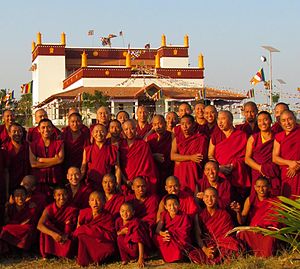Sangha

Sangha (Skt. saṅgha; P. saṅgha; T. dge ’dun; C. sengqie; J. sōgya; K. sŭngga 僧伽). Literally "community", "association", "assembly", etc.
In traditional usage, the term sangha is used in two senses:[1]
- the monastic community of monks and nuns (bhikkhus and bhikkhunis, respectively), or
- the community of noble beings (āryapudgala).
The monastic communities are traditionally referred to as the bhikkhu-sangha and bhikkhuni-sangha.
The community of noble beings (āryapudgala) includes both monastics and lay persons who have attained a high level or realization. This community is referred to as the "arya sangha" (arya sangha).[2]
In modern Western Buddhist communities, the term sangha is commonly used to refer to all the members of a particular community, whether lay or monasitc.
Traditionally, the term pariṣad ("followers") is used to refer to the larger Buddhist community of both monastics and ordinary lay persons.
Ideal vs. conventional sangha
Robinson et al. (2005) describe the two meanings of sangha as follows:[3]
- This word has two levels of meaning:
- (1) on the ideal (arya) level, it denotes all of the Buddha’s followers, lay or ordained, who have at least attained the level of srotāpanna;
- (2) on the conventional (saṃvṛti) level, it denotes the orders of the Bhikṣus and Bhikṣunis.}}
Robinson et al. also state:[3]
- The two meanings overlap but are not necessarily identical. Some members of the ideal Sangha are not ordained; some monastics have yet to acquire the Dharma-eye.
The original sangha
The original sangha refers to the first followers of the Buddha. The very first members of this sangha were the five ascetics, the five former companions of the Buddha who received his first teaching and immediately became his follers.
The sangha within the Three Jewels
Within Buddhism, the Sangha is identified as the third of the Three Jewels.[4][5] In this context, the term sangha refers to the "sangha of the nobles ones" (arya sangha).
Qualities of the arya sangha
Pali tradition
In the Pali tradition, the noble sangha (aryiya sangha) is:[2]
- worthy of gifts
- worthy of hospitalities
- worthy of offerings
- worthy of reverential salutation
- the unsurpassed field of merit for the world.
Sanskrit tradition
According to Maitreya's Uttaratantra Shastra, the sangha of the noble ones (arya sangha) has "eight qualities of knowledge and liberation" (T. rig grol gyi yon tan brgyad). These eight qualities are:
- Knowledge of:
- 1) the profound nature of phenomena
- 2) the vast – phenomena in all their multiplicity
- 3) discriminating awareness wisdom
- 1) the profound nature of phenomena
- Liberation of:
- 4) attachment, the emotional obscurations
- 5) hindrance, the cognitive obscurations
- 6) the inferior – the obscurations of the shravakas and pratyekabuddhas
- 4) attachment, the emotional obscurations
- And
- 7) knowledge; and
- 8) liberation.
See also
Notes
- ↑
 Refuge (glossary), Access to Insight
Refuge (glossary), Access to Insight
- ↑ 2.0 2.1
 Sangha (definition), Access to Insight
Sangha (definition), Access to Insight
- ↑ 3.0 3.1 Robinson et al.(2005). "Buddhist Religions: A Historical Introduction". Fifth Edition. Belmont,CA: Wadsworth/Thomson, p.327
- ↑ Going for Refuge and Taking the Precepts, Kandy 1981, Wheel leaflet 282/284, Bhikku Bodhi, P 49 (Of the Collected Wheel publications XIX)
- ↑
 What is the Triple Gem?, Access to Insight
What is the Triple Gem?, Access to Insight
Further reading
 Sparham, Gareth (2004), "Sangha", in Buswell, Robert E., Encyclopedia of Buddhism, vol 2, Macmillan Reference USA, pp. 740–744
Sparham, Gareth (2004), "Sangha", in Buswell, Robert E., Encyclopedia of Buddhism, vol 2, Macmillan Reference USA, pp. 740–744- "Duties of the Sangha" by Ajaan Lee Dhammadharo
 Sangha, Wikipedia
Sangha, Wikipedia